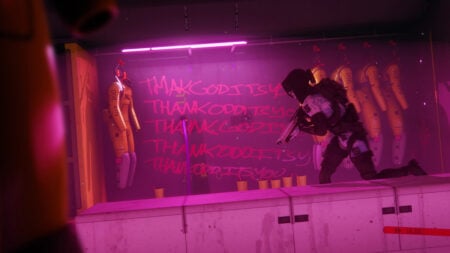Skip To...
In the ever-growing landscape of zombie-riddled gaming experiences, one that stands out thanks to its parkour antics and combat mechanics that lean more toward the realistic side is the Dying Light series. Its 2015 debut hooked many players who were dying to perform flying kicks at a zombie face while doing a frontflip from one building to another. Now, 10 years later, Dying Light: The Beast is here, and it sees the return of the man who started it all into a new land full of infected denizens, gorgeous visuals, and new skills that make everyone embrace their berserker side.
Unleash the Beast

A decade after we saw our favorite parkouring hero, Kyle Crane, return for one more adventure in an unknown land full of some familiar dangers and a new one.
The story takes place after the events of The Following, where Crane was captured and became a test subject for over a decade. After being trapped inside the walls of a mysterious research facility, a catastrophe occurs that frees an even more dangerous test subject, who starts rampaging around the facility and allows Crane to escape. A couple of tutorial sequences later, Crane is now in Castor Woods, ready to embrace this new, picturesque landscape and his new beastly powers.
The overarching plot sees Kyle trying to get revenge on the Baron, the person who imprisoned him for many years. To ensure his vengeful goal succeeds, he must hunt several creatures to boost his Beast abilities and take down the big baddie.

One thing that makes the story stand out so much, besides the return of our first hero, is the fact that he’s out in a world that has progressed without him being part of it. Of course, this justifies our protagonist’s weakening, but also adds to the conflict of Crane trying to help others with information that has become obsolete. It is a creative way to de-level a powerful character and one that adds another immersion layer to Kyle’s triumphant return.
As a quick note, I haven’t finished the story yet. Truth is, Dying Light: The Beast is a huge game with many things to do, so I didn’t want to rush the plot. With that in mind, I will update the score once I see the credits roll. But so far, the plot seems quite promising and one of the best in the trilogy.
Zombie-killing at its Finest

A key element of the Dying Light series has always been the combat that aims for these over-the-top, gory moments while also keeping a realistic feeling by adding weight behind every shovel hit or punch you throw. Dying Light: The Beast maintains that, but elevates it by adding even more gore and the highly devastating Beast mode that just gets better as you level it up.
Assuming Dying Light: The Beast is your first rodeo, the combat is as flashy as it is realistic. To defend against the infected, you can use your fists, a plethora of melee weapons scattered around the world, or even craft your own post-apocalyptic armaments like a homemade flamethrower or exploding throwing knives. To add an extra punch, there are also weapon mods you can equip to add new effects, such as poison or even bleeding.
There’s also an easy-to-grasp upgrading system that lets you unlock better versions of an existing blueprint by finding crafting manuals in the world and some rare materials. Doing so will let you craft a weapon or item with better durability, damage, or even extra effects. I’ve always liked this approach, as it is a way to encourage players to go around the world and scavenge for supplies until they have that ultimate zombie survivalist weapon.
Yet, weapons aren’t your only means to fend off the undead horde. Kyle Crane has many skills you can unlock, ranging from the iconic flying kick, ground pound, and a few passive skills that lean into a utility role, such as a way to sneak around enemies easily, and even one perk that lets you use zombie remains to camouflage yourself. The skill tree might seem small at first, but every unlockable ability is impactful, and I prefer that approach instead of a bloated tree that I’ll never finish filling up.

On top of that, and what I consider the cherry on top of our returning protagonist, is the new Beast mode. This feature allows Kyle to go berserk after filling up a bar, which happens by either taking damage or fighting many enemies at the same time. Once it triggers, Kyle will unleash his inner Beast, which is a result of his human and infected DNA cocktail, and will literally tear the limbs off of his enemies in one of the most visually satisfying combat experiences.
However, it isn’t all punching and limb-tearing, as there is also a surprisingly big skill tree for the Beast mode, which unlocks abilities that let Kyle pick up boulders and throw them at enemies, sprint at a high speed to knock zombies away, and even allow you to control when you want to go into Beast mode and how long it will last.
All in all, Dying Light: The Beast features the best combat in the series. It still has that realistic weight behind it, but it makes its gore and dismemberment mechanics feel flashier by adding new finishers or new ways to cut a zombie in half. Plus, it really embraces the fantasy of struggling with that inner demon of sorts that is a treat to watch when it gets unleashed, especially in first person.
Welcome to Castor Woods

An outstanding part of Dying Light: The Beast, and one of the best in this entry, is Castor Woods, which is one of the most beautiful yet terrifying locales I’ve seen in a zombie survival game.
You’re dropped into this European town surrounded by mountains and full of colorful homes with conveniently placed ledges and chimneys ready to let you parkour around these zombie-filled streets. While I’ll never forget the map of Dying Light fondly, Castor Woods has easily become my favorite one of the franchise.
What makes it so great is how it plays with its verticality. Almost every building in the game has multiple floors you can enter to scavenge, and when outside, there are numerous objects that can let you reach the next rooftop or cross a street that is a mini-hell of infected enemies.
Of course, Dark Zones return to the game, too, and are more terrifying than ever. Each of these high-risk, high-reward areas features at least one powerful infected or many volatiles, and you either have to go in quietly or bring your A-game to take them all down. As expected, these places house the best loot in the game, and I was glad to see that there were so many just in the game’s first area, with many more around Castor Woods that you can farm almost indefinitely to get better materials.
In terms of exploration, Dying Light: The Beast maintains that immersive discovery feel where it lets you create your own path. While the quests are marked and some side objectives will always tell you where to go, the road from point A to point B is up to you, and this is the type of freedom that many modern open-world games should provide to the player. Plus, since there isn’t a proper fast-travel mechanic of magically teleporting you to another location, it makes every moment of the game feel unique, as you never know what is lurking around the corner.

One minor complaint, however, and this is something that has been around for a while, is that the camera can go wild when climbing certain places. In terms of parkour mechanics and climbing, they are still great and some of the best in the market. However, I encountered a few instances where Kyle clipped through a wall or missed the ledge that should’ve been an easy climb. They didn’t happen that often, but when they did, they broke that fast-paced parkouring action and broke the immersion a bit.
Minor issues aside, environmental storytelling, which is a staple of the series, returns to Dying Light: The Beast. To give you a quick example, I was exploring the game’s first area and found myself inside a hotel room. This room had a note talking about a safe code and led me to a Dark Zone. I found a clue to the code there and then returned to solve the puzzle and loot the safe. This side adventure of mine never appeared on the map, nor was it part of an optional quest. It was an unfinished tale that I decided to follow, and in the end, it rewarded my curiosity and drive to explore.
I could keep gushing about Castor Woods, but I would never finish. The truth is that this is one of the best zombie survival sandbox experiences of recent years, and one that will be hard to replicate, as there’s no other map that has the depth, verticality, and mystery of this eerie mountain town. Also, for those wondering about the technical aspect, it runs smoothly on a base PS5 in performance mode, with it hitting 60 FPS effortlessly and without compromising its stunning visuals.
Crane’s Heroic Comeback

When Dying Light 2 launched, it seemed more like an extension to the first game than an actual sequel. Dying Light: The Beast, on the other hand, feels like the proper sequel we were all waiting for, which is fitting thanks to the original protagonist’s return. While it retains many iconic elements from the series, its new additions, such as the beast mode and the gorgeous yet eerie Castor Woods, make The Beast the best entry of this trilogy.
After playing for dozens of hours, I’m convinced this is the ultimate zombie survival experience of the year. On top of that, it is a technical achievement in many ways. It has some of the most stunning visuals I’ve seen in a first-person game, and it also brings a seamless co-op mode that lets you do almost everything together. Overall, it is the triumphant return of one of the most unique survival horror series out there, and one I will not soon abandon due to how addictive and alluring it is.
Review copy provided by the Publisher.
Dying Light: The Beast (PS5 Reviewed)
Dying Light: The Beast is the promised sequel we were all waiting for. Its new combat additions make fighting more enjoyable and visceral, while Castor Woods provides not only the best setting of the franchise but also the ultimate post-apocalyptic parkour sandbox.
Pros
- The new Beast mode is superb
- Gorgeous visuals that don't affect performance at all
- Castor Woods is one of the best locations in the series
Cons
- The story starts a tad slow
- A couple parkour clipping issues










